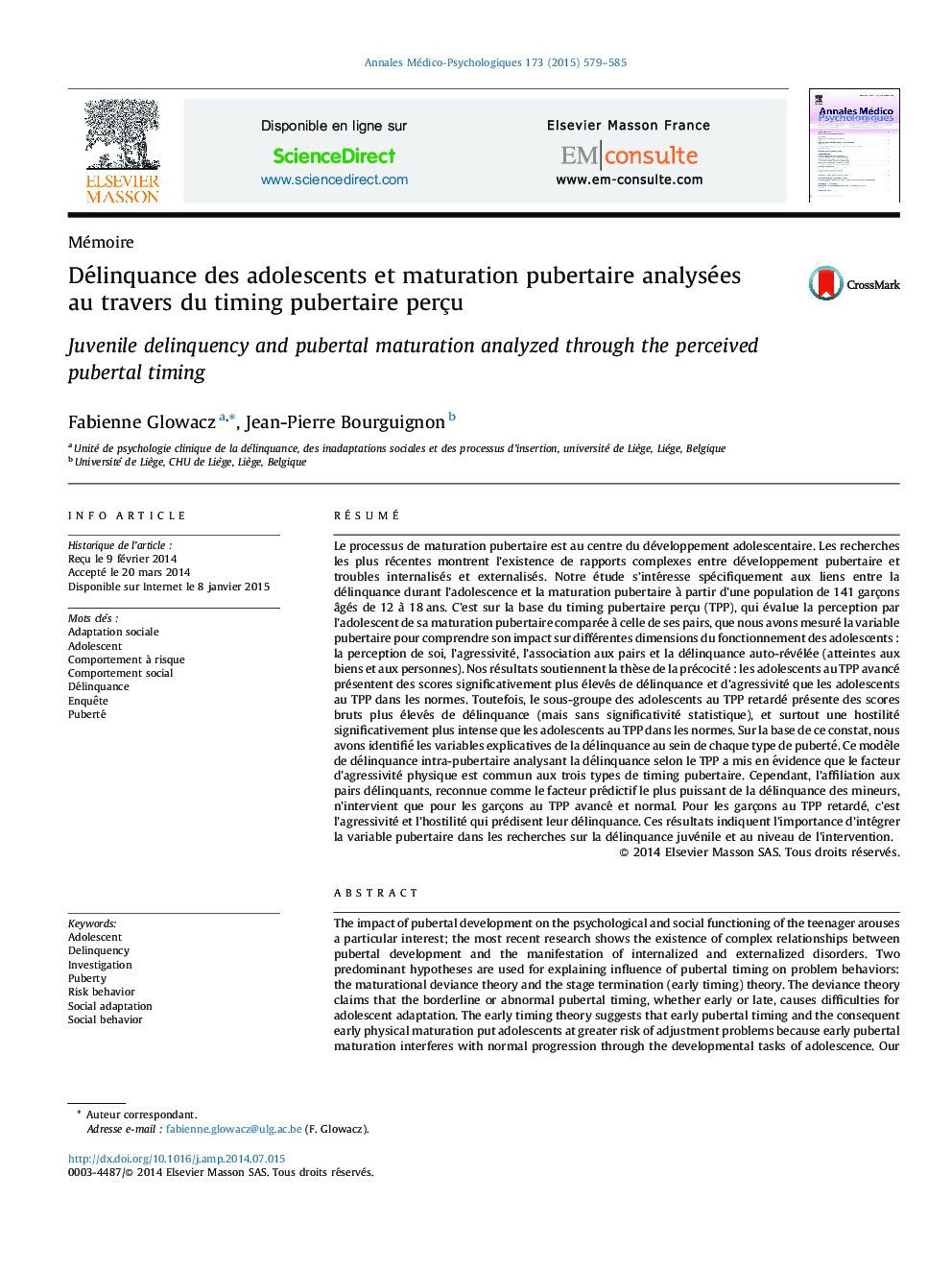| کد مقاله | کد نشریه | سال انتشار | مقاله انگلیسی | نسخه تمام متن |
|---|---|---|---|---|
| 313699 | 534526 | 2015 | 7 صفحه PDF | دانلود رایگان |

RésuméLe processus de maturation pubertaire est au centre du développement adolescentaire. Les recherches les plus récentes montrent l’existence de rapports complexes entre développement pubertaire et troubles internalisés et externalisés. Notre étude s’intéresse spécifiquement aux liens entre la délinquance durant l’adolescence et la maturation pubertaire à partir d’une population de 141 garçons âgés de 12 à 18 ans. C’est sur la base du timing pubertaire perçu (TPP), qui évalue la perception par l’adolescent de sa maturation pubertaire comparée à celle de ses pairs, que nous avons mesuré la variable pubertaire pour comprendre son impact sur différentes dimensions du fonctionnement des adolescents : la perception de soi, l’agressivité, l’association aux pairs et la délinquance auto-révélée (atteintes aux biens et aux personnes). Nos résultats soutiennent la thèse de la précocité : les adolescents au TPP avancé présentent des scores significativement plus élevés de délinquance et d’agressivité que les adolescents au TPP dans les normes. Toutefois, le sous-groupe des adolescents au TPP retardé présente des scores bruts plus élevés de délinquance (mais sans significativité statistique), et surtout une hostilité significativement plus intense que les adolescents au TPP dans les normes. Sur la base de ce constat, nous avons identifié les variables explicatives de la délinquance au sein de chaque type de puberté. Ce modèle de délinquance intra-pubertaire analysant la délinquance selon le TPP a mis en évidence que le facteur d’agressivité physique est commun aux trois types de timing pubertaire. Cependant, l’affiliation aux pairs délinquants, reconnue comme le facteur prédictif le plus puissant de la délinquance des mineurs, n’intervient que pour les garçons au TPP avancé et normal. Pour les garçons au TPP retardé, c’est l’agressivité et l’hostilité qui prédisent leur délinquance. Ces résultats indiquent l’importance d’intégrer la variable pubertaire dans les recherches sur la délinquance juvénile et au niveau de l’intervention.
The impact of pubertal development on the psychological and social functioning of the teenager arouses a particular interest; the most recent research shows the existence of complex relationships between pubertal development and the manifestation of internalized and externalized disorders. Two predominant hypotheses are used for explaining influence of pubertal timing on problem behaviors: the maturational deviance theory and the stage termination (early timing) theory. The deviance theory claims that the borderline or abnormal pubertal timing, whether early or late, causes difficulties for adolescent adaptation. The early timing theory suggests that early pubertal timing and the consequent early physical maturation put adolescents at greater risk of adjustment problems because early pubertal maturation interferes with normal progression through the developmental tasks of adolescence. Our study is interested specifically in the links between delinquency during adolescence and pubertal maturation in a population of 141 boys aged between 12 and 18. We measured the pubertal variable starting from the perceived pubertal timing (PPT), which evaluates the teenagers’ perception of their pubertal maturation, compared with that of their peers, to understand its impact on various dimensions of the functioning of teenagers: the self-perception (scale of Harter), aggressiveness (scale of Buss and Perry), association with peers and self-reported delinquency (attacks on property and individuals). We began with univariate analyses in order to determine the variables associated with early or late pubertal timing through comparison of scores obtained in those subjects with reference to average maturers. Subsequently, multivariate analyses were used in an attempt to sort out which among the studied factors could be predictor or a determinant of delinquency in relation to pubertal timing. Therefore, stepwise multiple regression analysis was performed. Statistical analyses were run with the SAS software, version 9.1. Our results support the thesis of precocity, the teenagers with an advanced PPT present score of delinquency and aggressiveness significantly higher than teenagers with a standard PPT. However, the sub-group of teenagers with delayed PPT present raw scores of self-revealed delinquency, which are higher than those of teenagers with a standard PPT. These teenagers can be characterized by a significantly higher hostility than the teenagers with a standard PPT. This cognitive dimension of aggressiveness, as evaluated by Buss and Perry, characterizes the functioning of the teenagers with the delayed PPT, who also present poorer self-esteem and dissatisfaction with their physical appearance. On the basis of this assessment, an analysis of multiple regression within each type of PPT aimed at identifying the variables likely to explain the delinquency of teenagers according to their PPT. The results show that the physical factor of aggressiveness is common to the three types of PPT. It is associated with the affiliation with delinquent peers for those teenagers with advanced and normal PPT, whereas for those teenagers with delayed PPT, it interacts with the factor of hostility, which is specific to them. Association with delinquent peers recognized as a major risk factor and predictive for the self-revealed delinquency of teenagers in general does not intervene for these boys who perceive their pubertal development late, compared to the others. The delinquency of teenagers with a delayed PPT cannot be explained by the factors that are considered in the general population, their social functioning and the socialization of these teenagers with delayed puberty is different from that of the other teenagers, as is their implication in delinquency, which is not explained by a kind of socialization with delinquent peers. These results confirm the importance of integrating the puberty variable into research on delinquency, but also at the level of intervention.
Journal: Annales Médico-psychologiques, revue psychiatrique - Volume 173, Issue 7, September 2015, Pages 579–585